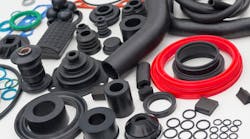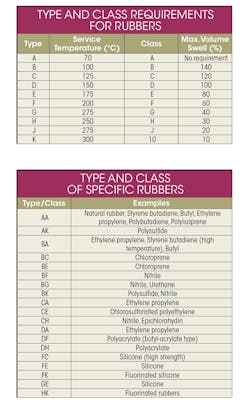This file type includes high resolution graphics and schematics when applicable.
Material experts at the American Society for Testing and Materials (ASTM) have codified the type and class designations for rubber in its standard, ASTM D 2000. The type designation, a single alphanumeric consisting of a letter from A through J, indicates the rubber’s temperature resistance. It is determined by subjecting the rubber to an ASTM-defined test. In the test, researchers determine the highest temperature the rubber can be held at 70 hours and change its tensile strength by no more than 30% and lose 50% or less of its hardness or less. This is the rubber’s service temperature. The letters A through K cover the range from 70° to 300°C.
The class designation, another single alphanumeric, divides rubbers into categories based on how much they resist swelling. To determine this, researchers immerse the rubber in IRM No.903 oil for 70 hours. The oil is kept at the rubber’s service temperature. However, the maximum oil temperature is 150°C. Any hotter and the oil is unstable. The researchers than measure how much the rubber sample swelled. Swelling is then given as a percent of the original size. The values for the A to K Class designations range from 140% to 10%
Type and class are often written together to identify broad groups of rubbers by performance. For example, AK identifies a rubber that can be used continuously at 70°C and it will not swell more than 10% when immersed in the ASTM reference oil.
This file type includes high resolution graphics and schematics when applicable.



